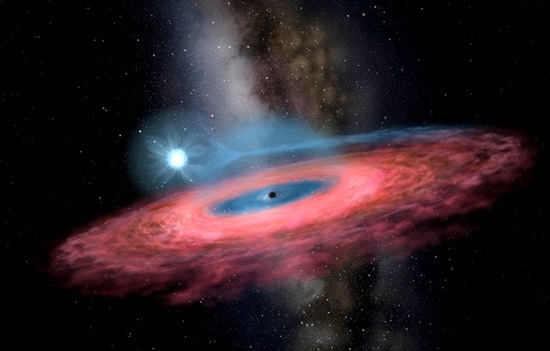Nov 28 2019
An international study involving Monash astronomers has discovered for the first time that some black holes may be born more than twice the size than previously thought.
 An artist’s impression of the new black hole observation. Image Credit: Yu Jingchuan
An artist’s impression of the new black hole observation. Image Credit: Yu Jingchuan
The observation is outlined in a study published today in the prestigious journal Nature.
The study by an international team of scientists led by Professor Jifeng Liu, at the National Astronomical Observatory of China, Chinese Academy of Sciences, has identified a stellar black hole with a mass 70 times that of the Sun.
The team of astronomers surveyed the sky with the LAMOST optical telescope in north-east China to look for stars that orbit around an invisible object, pulled by its gravity. The LAMOST telescope allows astronomers to find binary stars systems, and provides a better understanding of the fates of the most massive stars and the black holes they make.
“This search was by no means an easy task. Only one star in a thousand may be going round a black hole: it is like trying to find a needle in a haystack,” said Professor Liu.
Study collaborator and co-author Professor Alexander Heger from the Monash University School of Physics and Astronomy said It was remarkable that this black hole had been found close-by in our own galaxy, and not in distant galaxies such as those detected by LIGO.
“This newly discovered black hole is a young black hole, at most a few million years old, and is in our ’neighbourhood,' unlike the old and remote black holes detected by LIGO,” Professor Heger said.
“Astronomers have often asked how big a black hole can stars make?
“The current view is that the stars in our galaxy cannot easily make a black hole bigger than 45 times the mass of the sun.metallicity.
“But the black hole we have observed is more than 50 per cent larger than this limit.
“We will now be able to make many detailed follow-up observations using a wide range of ground-based and space-borne telescopes.”
Professor Liu said the discovery came as a great surprise.
“Black holes of such mass should not even exist in our Galaxy, according to most of the current models of stellar evolution," he said.
“Now theorists will have to take up the challenge to explain its formation in a solar metallicity environment."
The newly discovered monster is located 15 thousand light years from Earth and has been named LB-1 by the discovering team.
Recent technological developments of telescopes and detectors have made this quest possible, more than 200 years after this technique was first proposed by the visionary English scientist John Michell. LB-1 is the result of such search: a star eight times bigger than the Sun was seen orbiting around a 70-solar-mass black hole, one cycle every 79 days.
Commenting on the discovery fellow astronomer Professor Ilya Mandel from the Monash School of Physics and Astronomy said it was a hugely exciting result.